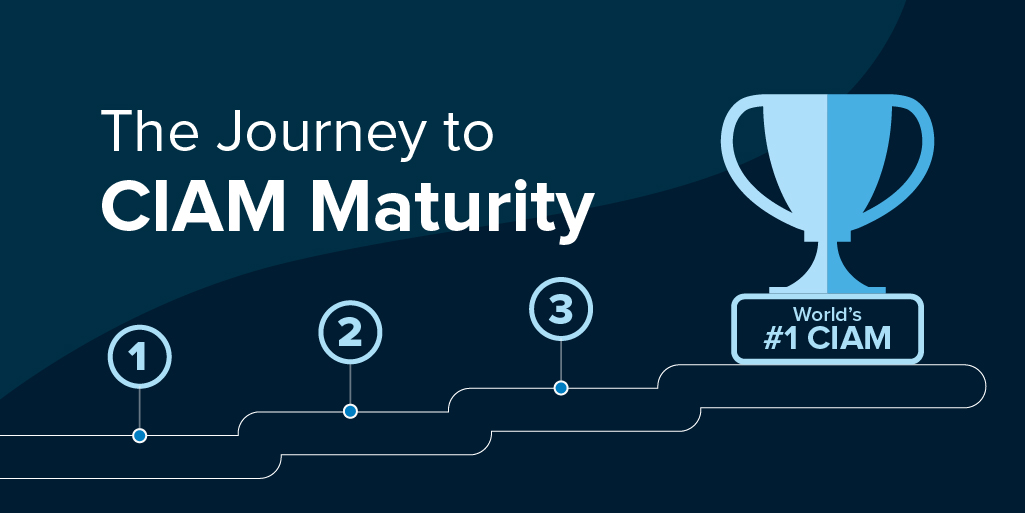The Journey to CIAM Maturity: Delight Your Customers with Embedded Automation
We’ve said before that most organizations out there are only at a basic stage of CIAM maturity—and that’s still true. However, companies that invest in modern identity solutions, like Okta, are quickly graduating to the second stage of the CIAM Maturity Curve.
We call this stage “Automated.” Why? Because in this phase, the organization has built infrastructure for their apps and adjacent processes that operate intelligently and seamlessly for both customers and admins.
From the moment customers begin their sign-in or sign-up flows, security solutions are already in place to check for common or compromised passwords and ensure password complexity, adding a critical layer of protection for business and customer data. Meanwhile, multi-factor authentication (MFA) ensures that end users aren’t just relying on a single set of static credentials.
Organizations at the second stage of the CIAM Maturity Curve not only benefit from centralized user management, but from automated provisioning and deprovisioning. This creates efficiencies for admins and end users alike, while ensuring inactive accounts can’t be hijacked by hackers. All of this might sound ambitious, but this must be the baseline for an organization committed to building, delivering, and securing digital products and services for their customers. Here’s a look at what a company typically looks like when it’s time to adopt automated customer identity.
Automated CIAM for growing businesses
In the previous stage of the CIAM Maturity Curve, a company needing basic customer identity is probably developing or rolling out its first app—but a company that requires automated customer identity has already done this successfully, perhaps more than once, and is now fully focused on delivering exceptional products and user experiences repeatedly at scale.
What may have once been a small developer and operations team dedicated exclusively to building and selling the product has now become a collection of collaborative departments with developers, technical managers, and product managers, and may be overseen by a CTO, VP of Products, or VP of Engineering.
But as the organization evolves, so do customers’ expectations—and those of regulators. With multiple apps being used by a global consumer base, compliance requirements like GDPR and CCPA matter more than ever, which is why developers can’t sidestep comprehensive authentication and authorization. At the same time, the growing user base wants more advanced features, integrations, and identity capabilities so they can enjoy a friction-free experience while knowing their data is safe.
While contending with these various components, organizations also have to consider the needs of their developers, who are vastly more interested in working on the core, unique functionalities of their systems instead of login pages and policies. By relieving developers of these tasks, companies can better enable their teams to focus on making their offerings even better.
The goals of the organization’s DevOps teams and senior leadership are aligned: long-term, sustainable growth, driven by an ability to efficiently and securely scale their digital offerings. To do that, CIAM is critical.
Taking the complexity out of customer identity
With so much riding on the success of the product, as well as its regulatory compliance, it’s more important than ever to get identity right—and the best way to do that is to rely on a third-party provider with best-in-class tools ready to deploy.
You need a CIAM solution that allows you to scale user management while reducing the risks associated with external identities. That means having a system that can federate end users into your app through their existing identities and identity providers, while connecting to other organizations through the process of social authentication. They have a seamless experience; and you have complete oversight and control.
Open standards such as SAML and OpenID Connect (OIDC) allow for advanced inbound federation so that your customers can authenticate through third parties or social logins. In addition, these current common standards allow you to enhance your own security while leveraging both industry best practices and an entire ecosystem of tools, libraries, integrations, and training. Having a partner like Okta to provide this, while also keeping track of changing identity and security standards such as JWT, SAML, OAuth2.0, OIDC, Fido, and PKCE takes a load off your security team.
Secure authentication and authorization through password security, account recovery flows, MFA, and automated lifecycle management help you mitigate the risk of compromised accounts. And by leveraging hooks, a CIAM solution like Okta’s can extend its core platform functionality within processes such as registration, user import, and authentication.
It doesn’t end with automated CIAM
Stage 2 of the CIAM maturity curve is a good place to be, but you can go a lot further. Before you do, make sure that you've extended access management not just to your customer identities, but to the APIs that power your apps. Okta’s CIAM solution lets you configure granular controls for API access in your admin dashboard.
Once you have single sign-on, MFA, secure reset flows for your authentication, powerful authorization policies for your applications and APIs, and centralized user management that enables advanced inbound federation, then you’re ready for Stage 3.
The Okta Identity Cloud connects your teams with the best-of-breed tools they need to bring Automated CIAM to your apps, and we offer a free developer plan to help you implement the identity and security features your organization needs. As you continue your trajectory along the CIAM Maturity Curve, check out our eBook, From Zero to Hero: The Path to CIAM Maturity.


